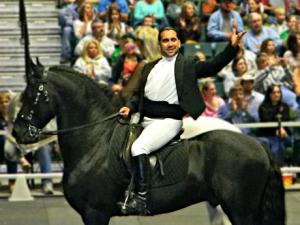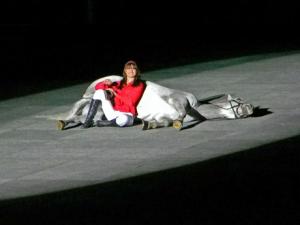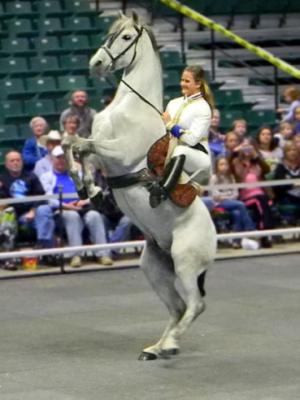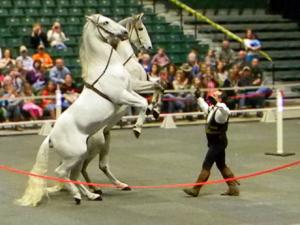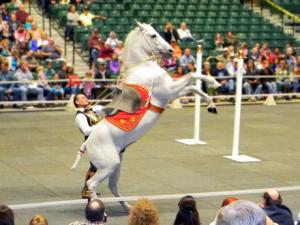By Cori Webb
This year, the Gala of the Royal Horses was warmly welcomed for the very first time in North America, with tour dates set for multiple venues throughout the United States. Horse enthusiasts filled the seats of three venues in the mid-south during mid-March. Audiences enjoyed the entertaining and family-friendly event that pays tribute to the royal horse breeds of Europe: the Arabian, Andalusian, Lipizzaner, and Friesian. Rene Gasser, a seventh generation horseman, is the head trainer and lead producer for the event, which has been touring worldwide for fourteen years. According to Gasser, “This is a celebration of the royal horse… and not just the horses, but also the art form, the costumes, the saddles, so it’s the whole thing.”
The show highlighted the characteristics of the four royal breeds and their services to mankind during ancient wars. Each breed was given their moment in the spotlight, allowing the audience to better understand the history of the breed and their significance to humans throughout the centuries. Friesian soldiers originally used the Friesian during wars against the Romans, and the horse eventually carried the knights of northern Europe into battle during the Crusades. Today’s modern Friesian breed has more emphasis placed on the horse’s natural athletic abilities and grace. The Arabian breed is said to have originated around the time of man, created from the south wind by God. The breed is the foundation for many other horse breeds, and continues to be the model breed for the equine species today. Known for their strength, beauty, and proud carriage, Lipizzaners were used for nearly 500 years as warhorses. General George Patton rescued the breed during WWII, when he secured the the last 200 Lipizzaners in a raid, ensuring their survival. The Andalusian originated in a region of southern Spain, known as Andalusia. The breed expanded throughout Europe during times of war, but soon undertook a new line of work as riding horses for the equestrian riding academies that formed during the Renaissance.
The show gave prominence to the fact that a horse is not well trained through the use of mechanics and force, but through time, trust, and understanding. Only then will the horse illustrate its true beauty, grace, and abilities. Gasser is very passionate about the horses’ training and well being, and takes into great consideration which horse and rider will pair the best. Gasser explains, “For the softer horse, we’ll try to pick somebody that is a bit more soft; for some of the lazier horses, we pick someone who is a bit more enthusiastic… That’s probably one of the most important things, so we can find the right rider for the right horse.” The true bond between Katharina Gasser and her stallion, Mozart, was obvious as the duo performed several acts at liberty, such as the bow and laying down on command. Rene Gasser brought out several horses of various skill levels to demonstrate how the horses are taught to perform certain maneuvers, such as the Spanish walk and piaffe. Gasser explained how all training begins on the ground, before transitioning into cues from the rider’s hands, legs, and seat. Gasser stated, “As you see, when you do it right, horses love to do this. They love to work, they are working animals.”
Prior to executing the piaffe, Gasser explained that the maneuver was originally designed during war as a means to allow the horses to warm up their muscles and become physically and mentally prepared for battle while remaining stationary. Additionally demonstrated war moves, aptly named “The Airs Above The Ground,” included the levade, battle mezair, and capriole. The battle mezair was utilized in war to terrorize ground soldiers with flailing hooves from above. Similarly, the capriole was used to defend the horse and rider when soldiers would approach the horse from behind. Each of these maneuvers, once designed for war, are now appreciated for their complexity and beauty in dressage and equestrian riding schools.
In addition to displaying the war maneuvers, the event played host to several harmonious performances between multiple horses and riders, all of whom were clad in traditional Spanish attire and equipment. The final performance included the Dancing Gauchos, an energizing couple who entertained the crowds with pounding drums, flaming whips, and dangerous Boleadoras, an ancient throwing weapon composed of weights tied to the ends of long ropes.
The Gala of Royal Horses continues their tour at several venues in Florida through April, with additional tour dates to be announced. Gasser and his team were also invited to perform on the Fox and Friends show on March 19th in New York City, which was no small feat to arrange! Being met with such enthusiasm and appreciation from the crowds at such an early stage in their North American tour, it can almost be guaranteed Gasser and the Gala of the Royal Horses crew will be making their rounds across the United States again in the future.
This year, the Gala of the Royal Horses was warmly welcomed for the very first time in North America, with tour dates set for multiple venues throughout the United States. Horse enthusiasts filled the seats of three venues in the mid-south during mid-March. Audiences enjoyed the entertaining and family-friendly event that pays tribute to the royal horse breeds of Europe: the Arabian, Andalusian, Lipizzaner, and Friesian. Rene Gasser, a seventh generation horseman, is the head trainer and lead producer for the event, which has been touring worldwide for fourteen years. According to Gasser, “This is a celebration of the royal horse… and not just the horses, but also the art form, the costumes, the saddles, so it’s the whole thing.”
The show highlighted the characteristics of the four royal breeds and their services to mankind during ancient wars. Each breed was given their moment in the spotlight, allowing the audience to better understand the history of the breed and their significance to humans throughout the centuries. Friesian soldiers originally used the Friesian during wars against the Romans, and the horse eventually carried the knights of northern Europe into battle during the Crusades. Today’s modern Friesian breed has more emphasis placed on the horse’s natural athletic abilities and grace. The Arabian breed is said to have originated around the time of man, created from the south wind by God. The breed is the foundation for many other horse breeds, and continues to be the model breed for the equine species today. Known for their strength, beauty, and proud carriage, Lipizzaners were used for nearly 500 years as warhorses. General George Patton rescued the breed during WWII, when he secured the the last 200 Lipizzaners in a raid, ensuring their survival. The Andalusian originated in a region of southern Spain, known as Andalusia. The breed expanded throughout Europe during times of war, but soon undertook a new line of work as riding horses for the equestrian riding academies that formed during the Renaissance.
The show gave prominence to the fact that a horse is not well trained through the use of mechanics and force, but through time, trust, and understanding. Only then will the horse illustrate its true beauty, grace, and abilities. Gasser is very passionate about the horses’ training and well being, and takes into great consideration which horse and rider will pair the best. Gasser explains, “For the softer horse, we’ll try to pick somebody that is a bit more soft; for some of the lazier horses, we pick someone who is a bit more enthusiastic… That’s probably one of the most important things, so we can find the right rider for the right horse.” The true bond between Katharina Gasser and her stallion, Mozart, was obvious as the duo performed several acts at liberty, such as the bow and laying down on command. Rene Gasser brought out several horses of various skill levels to demonstrate how the horses are taught to perform certain maneuvers, such as the Spanish walk and piaffe. Gasser explained how all training begins on the ground, before transitioning into cues from the rider’s hands, legs, and seat. Gasser stated, “As you see, when you do it right, horses love to do this. They love to work, they are working animals.”
Prior to executing the piaffe, Gasser explained that the maneuver was originally designed during war as a means to allow the horses to warm up their muscles and become physically and mentally prepared for battle while remaining stationary. Additionally demonstrated war moves, aptly named “The Airs Above The Ground,” included the levade, battle mezair, and capriole. The battle mezair was utilized in war to terrorize ground soldiers with flailing hooves from above. Similarly, the capriole was used to defend the horse and rider when soldiers would approach the horse from behind. Each of these maneuvers, once designed for war, are now appreciated for their complexity and beauty in dressage and equestrian riding schools.
In addition to displaying the war maneuvers, the event played host to several harmonious performances between multiple horses and riders, all of whom were clad in traditional Spanish attire and equipment. The final performance included the Dancing Gauchos, an energizing couple who entertained the crowds with pounding drums, flaming whips, and dangerous Boleadoras, an ancient throwing weapon composed of weights tied to the ends of long ropes.
The Gala of Royal Horses continues their tour at several venues in Florida through April, with additional tour dates to be announced. Gasser and his team were also invited to perform on the Fox and Friends show on March 19th in New York City, which was no small feat to arrange! Being met with such enthusiasm and appreciation from the crowds at such an early stage in their North American tour, it can almost be guaranteed Gasser and the Gala of the Royal Horses crew will be making their rounds across the United States again in the future.
